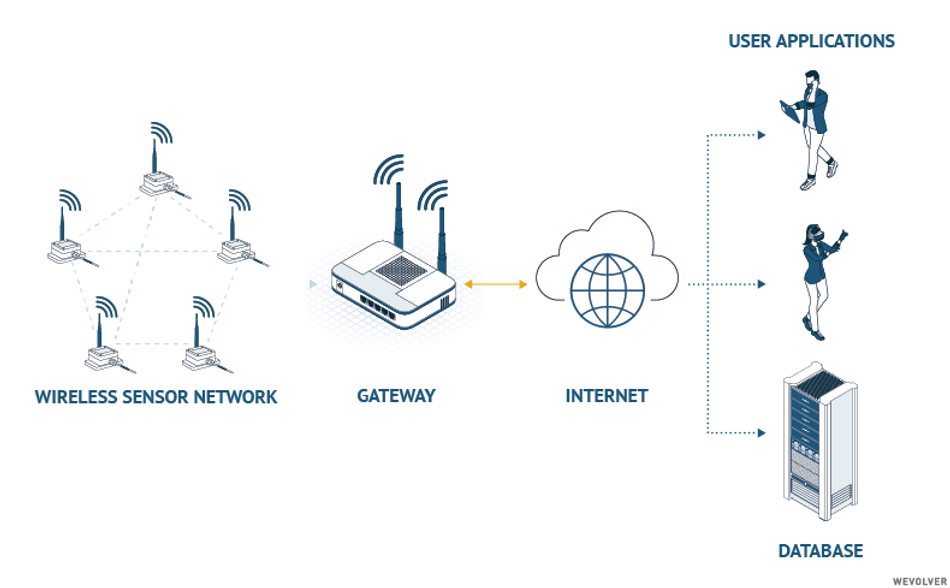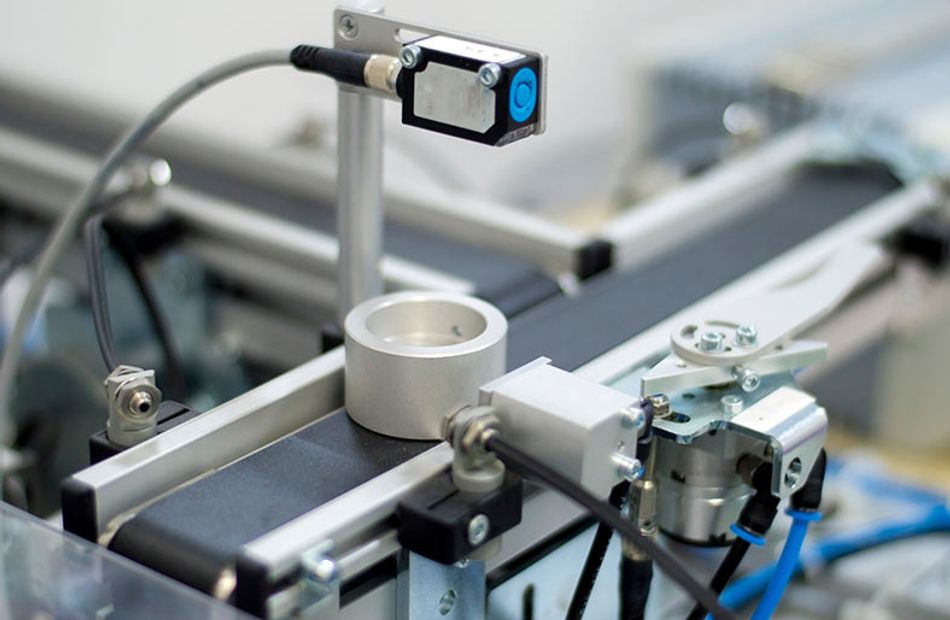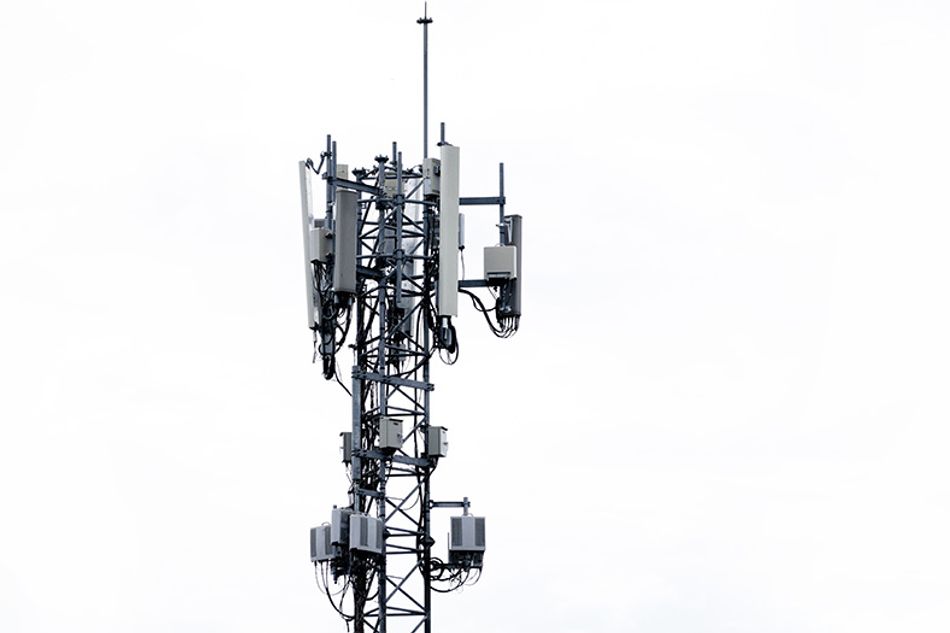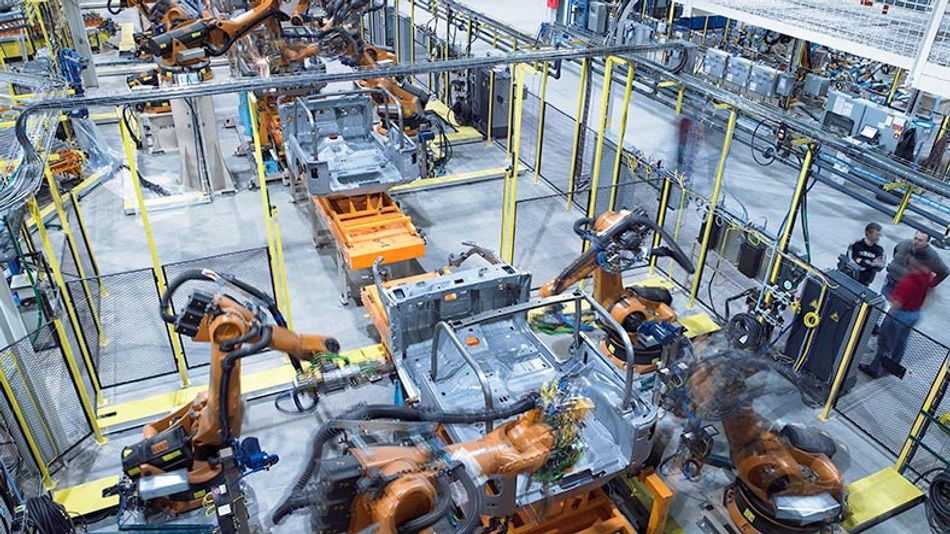Industry 4.0 Deep Dive. Part 3: Networks and Sensors
How ubiquitous sensors and next generation wireless connectivity are enabling Industrial IoT

Image: KUKA
Tags
This series investigates the current changes in the way we work and manufacture. It’s sponsored by KUKA, developer of industrial robots and solutions for factory automation. As a sponsor for this series on Industry 4.0, KUKA supports the spreading of knowledge about the technologies that create our factories of the future.
The Industry 4.0 series is written as a collaborative effort from experts in the field. After we at Wevolver wrote an outline of the articles we made a call-out in the Wevolver community for contributors. With their wide range of background and deep expertise these contributors crafted this and other articles in this series and we are grateful for their dedication.
The first article introduced the topic and gave an overview of what exactly Industry 4.0 is composed of. The second article showed how greater intelligence from big data and AI can revolutionize manufacturing. This third article focuses on the technologies for connecting sensors and machines throughout the factory.
Download the entire e-book here.
About the contributors
Athens, Greece
Honorary Research Fellow, IIoT, University of Glasgow.
Adjunct Professor, University of Sheffield, Athens Tech Campus.
Adjunct Professor, Information Networking Institute, Carnegie Mellon University.
Rodrigo Teles
Strasbourg, France
Ph.D. in Computer Science at the University of Strasbourg, focus on IoT.
Member of the Network Research Team of the ICube Laboratory.
Anish Jindal
Lancaster, United Kingdom
Senior Research Associate, IoT and Smart Grid, Lancaster University, UK.
Ph.D. Computer Science and Engineering, Thapar University.
Adriaan Schiphorst
Amsterdam, the Netherlands
Technology journalist and editor.
MSc Advanced Matter & Energy Physics at University of Amsterdam and the California Institute of Technology.
Previously editor at Amsterdam Science Journal.
Sydney, Australia
CEO and Co-founder Medulla
Research Associate, IoT and Smart Grid, Lancaster University.
Ph.D. in Physics, on Nonlinear Optics, at the University of Sydney.
Bachelor, Engineering Physics & Management at McMaster University.
Andreas Bihlmaier
Karlruhe, Germany
Co-founder and CTO of Robodev
Previously leader of the Cognitive Medical Technologies group in the Institute for Anthropomatics and Robotics - Intelligent Process Control and Robotics Lab (IAR-IPR).
Ph.D. in Robotics from Karlsruhe Institute of Technology (KIT).
Sophie Laurenson
Zurich, Switzerland
Ph.D. in Biochemistry, Biophysics and Molecular Biology, from the University of Cambridge.
Executive MBA, Business Administration and Management, the Smartly Institute.
Previously Senior scientist and innovation manager at The New Technology Group of Abbott.
Intro
Industry 4.0 incorporates a range of technologies with the potential to significantly transform industrial automation. Advances in sensing and communications enable real-time monitoring and control of equipment and processes. However, modern manufacturing environments pose several challenges. Across a factory floor, there may be hundreds of cyber-physical systems (CPS), including robotics, automated devices for quality control, and actuation platforms. Each asset or process could be associated with numerous sensors, connecting the physical and virtual worlds by translating real-world actions into data and vise versa. Furthermore, advanced analytics convert these large datasets into actionable insights in real-time. Continuous monitoring and real-time analysis on this scale requires dependability, resilience, security, and flexibility in the design of sensors, network, and computing architectures.
This article will explore recent advances in sensing and connectivity technologies and their applications in Industry 4.0. While the fundamental mechanisms underpinning sensor functionalities remain unchanged, there have been improvements in miniaturization, cost reduction and on-board resources. Moreover, significant advances in wireless network technologies have facilitated inter-sensor communications. These innovations have democratized industrial IoT by reducing capital costs and allowing access for smaller manufactures.
A note on terminology: The term Industrie 4.0 originated in Germany and describes the influence of the Internet of Things on industry and the digitization of industrial processes. The same concept is also described as ‘Industrial Internet of Things’ (IIoT) and Smart Manufacturing, but for simplicity in this series we’ll use the international term ‘Industry 4.0.’
Networks in current industrial IoT applications
Over the last four decades, advances in microelectronics have led to the development of numerous low-cost, multi-purpose sensors. These are capable of detecting changes in environmental variables, including temperature, humidity, pressure, and the presence of chemical compounds. Sensors are deployed in sensor nodes to obtain information about their environment and transmit the data to a computer for processing and interpretation.
Sensor technology
A sensor node usually includes a transceiver with an antenna for data transfer, a microcontroller for controlling the sensors, and an energy source. Sensor nodes are resource-constrained, with limited computing power, memory capacity, and battery life.[1] Sensors vary in terms of resources, ranging from simple devices that collect and transmit low data volumes to complex designs.
A sensor network is composed of a collection of sensor nodes. Traditionally, in industrial settings, networks of sensors are connected by wired infrastructure.[2] Processes are monitored and controlled using established digital technologies.[3] These systems are reliable but time-consuming and expensive to install and maintain. For large-scale manufacturing, the capital costs of installation can be economical when connecting a significant number of devices. However, for smaller manufacturers, the upfront cost of installation is usually prohibitive. These systems also lack flexibility and scalability, as it is challenging to modify hardwired infrastructure retrospectively. To enable Industry 4.0, reliable, flexible, and scalable deployment, networking, and monitoring of a large number of sensors is necessary.
Towards wireless networking technologies
Wireless Sensor Network (WSN) technology is the key to connecting entities in manufacturing settings. WSNs consist of spatially dispersed sensors for monitoring physical parameters and disseminating collected data to a central location. In WSN platforms, sensors connect to computing infrastructure via wireless communications technology. WSNs built for industrial environments share essential characteristics, including low operating costs, energy-efficiency, self-organization, and self-configuration.[4] They should be able to be rapidly deployed in a manner that allows for scalability, flexibility, and simple upgrading. Each of these characteristics place design constraints on sensors and networks such as dependability, IP connectivity, security, low power consumption, standards compliance, and cost.[5]

Modern sensor nodes contain more computational power compared to earlier generations. These devices can process data at the edge of the network, closer to where it is generated and used. This reduces the bandwidth and latency associated with data transfer between devices, enabling real-time data analytics. Sensor nodes may also connect with a local network through a gateway that acts as a bridge to the rest of the system. Gateway devices typically have more resources than sensor nodes, enabling data to be stored and processed closer to the edge of the network.
Wireless technology standards and protocols
In recent years, significant progress has been made in device design and standards such as IEEE 802.15.4 and IEEE 802.15.1.[6] IEEE 802.15.4 is the base technology for standards such as ZigBeePRO,[7] WirelessHART,[8] ISA100.11a,[9] and WIA-PA.[10]
ZigBee is a wireless transfer protocol used in personal area networks requiring low power, low data rate, and proximity. It is typically used in applications that require long battery life, secure networking, and limited data transmission.
WirelessHART is a protocol that extends traditional HART communications through wireless connectivity. It is highly encrypted to protect data, with a more extended range than Zigbee. Sensor nodes form a flat mesh network in which every device serves as both a signal source and repeater. This system design enables automatic redirection of data in the event of a disruption in the network.
ISA100.11a is a wireless standard developed specifically for the automotive industry.
WIA-PA (Wireless Networks for Industrial Automation and Process Automation) was developed by the Chinese Industrial Wireless Alliance as a secure alternative to wired communication protocols and is popular in the industry in China. These standards are designed for low power device connectivity and have been successfully deployed in process automation in the oil and gas, chemical, pulp and paper, and glass and mineral processing industries.[11, 12]
Current issues and vulnerabilities
The hardware and firmware components of sensor nodes and the network can cause a variety of defects in WSNs.[13] WSNs are inherently complex systems due to heterogeneity in sensor devices, network infrastructure, and applications. These complexities can lead to system faults and need to be addressed through well-designed system architectures that account for firmware and hardware constructions, as well as operating system (OS) kernels.[14]
WSN systems can also be vulnerable to disparities in network connectivity and function. Security attacks have been documented on ZigBeePRO, WirelessHART, WIA-PA, and ISA100.11a standards.[14] Security concerns are an essential issue for any business, and new research is focussing on designing network architectures and devices to combat security breaches. Blockchain technology also offers potential for improving security in remote monitoring applications by applying cryptographic algorithms to ensure the confidentiality of data on WSNs.
Interference from devices complying with other standards operating in the 2.4GHz range, such as IEEE 802.11, have also been observed. These problems lead to transmission errors and inefficiencies from energy depletion, increasing operational costs. Post-deployment tools continuously monitor WSNs by detecting network, firmware, or hardware issues.[15]
Interoperability between standards and devices
These systems enable manufacturers to analyze sensor data to inform decision making in real-time. However, many of these tools have been designed for specific applications and require dedicated hardware, consume power, and are complex to configure and use. Also, they might not allow for centralized management of sensor networks using various industrial standards. A classic problem that affects all IoT implementations is the lack of interoperability between standards and devices.

IoT suppliers may have proprietary hardware, software, and communications protocols. It becomes challenging to collect, integrate, and contextualize data in these settings. A recent report by McKinsey & Company estimates that “Of the total potential economic value the IoT enables, interoperability is required for 40 percent on average and nearly 60 percent in some settings.”[5] Novel approaches that use an “IoT in a Box” concept aim to integrate a connected gateway with a variety of sensors and an application. These systems are designed to be used with multiple suppliers, reducing issues of poor compatibility between entities produced by different manufacturers.
Integrating legacy equipment into IIoT environments also represents a challenge for manufacturers. Older generations of equipment and sensor nodes devices may not be compatible with modern WSNs platforms in software or hardware. The correct drivers and configuration files specific for the equipment may not be available, and it requires considerable on-site time to build custom equipment drivers. In these contexts, equipment libraries that interact with legacy equipment and push data to a centralized platform can help to integrate legacy systems.
Towards a new network standard
From a network of wires connecting sensors to a multiplicity of wireless sensor networks. As we mentioned earlier, Industry 4.0 needs reliability, flexibility and scalability. Although the aforementioned standards and protocols have all been improvements upon earlier networks, there has not yet been a one-size-fits-all solution. Whether due to interoperability issues or security issues, industry is collectively waiting for the mass implementation of 5G networks.
5G: A new standard in wireless connectivity
5G (Fifth Generation) is the most recent standard in wireless technology for digital cellular networks. The 5G frequency spectrum is divided into three classes based on bandwidth. Millimeter waves in the high-band frequencies from 24 GHz to 72 GHz are capable of the fastest speeds reaching up to 1–2 Gbit/s down. However, the signal reach is short, requiring more cells to achieve coverage and has difficulty in traversing solid structures. Mid-band frequencies, between 2.4 GHz to 4.2 GHz, can reach speeds in a 100 MHz wide band from 100–400 Mbit/s down. Finally, low band classes use a similar frequency range as 4G wireless technology.
5G networks operate at higher frequencies compared with 4G networks and support a higher device density. The latency of 4G networks averages 50ms and could reduce to 1ms with 5G. As computing transitions from hardware embedded within devices into the cloud, the potential for increased performance, flexibility, and cost-efficiency can be realized. The 5G architecture also allows edge processing resources hosted on a local network. This reduces latency, enabling data to be analyzed and acted on closer to the point of interest.
In addition to security and speed, wireless solutions should provide reliable coverage, predictable latency, high device density, and enable complete visibility and monitoring of equipment and data. A modern manufacturing setting could contain a high density of CPSs and associated sensors. The sheer volume of sensors and data generated requires substantial bandwidth to transmit. Low latency is necessary to facilitate rapid data transfer and analysis in real-time.
Moreover, low latency enables autonomous applications that require fast response times. Ensuring that network coverage and bandwidth are adequate to reduce latency and interference issues is challenging, but if implemented correctly, 5G eliminates the need for enterprises to implement expensive cable infrastructure. Due to flexible reconfiguration and the predicted widespread adaptation, 5G is also expected to solve interoperability issues. This offers further benefits in security for data and device integrity and presents an open platform for developing applications and services. Furthermore, because costs are lowering, smaller manufacturers can access these technologies easier than ever before, enabling the democratization of industrial manufacturing.
Case studies
Jeep Gladiator & Wrangler Manufacturing Plant, Toledo, Ohio, USA.
In April of 2019, Jeep and KUKA started the production of the new Gladiator bodyshell in their Toledo plant, using 279 robots and over 60,000 other devices with back-end monitoring systems and a new data management system. The overarching aim is to manufacture high volumes of a wide range of Jeep body shell models and varieties on the same production line.
Since KUKA and Jeep first partnered on the Toledo Plant in 2006, the platform has continued to evolve dynamically and has become one of the most efficient body-in-white (the stage in automobile manufacturing in which a car body's components have been joined together) production lines in the US automotive industry, aiming to produce 110.000 bodyshells a year.
To enable networking, and to mirror an “IoT in a Box” concept, KUKA integrated gateways, sensors, and applications. It was one of the first implementations to reduce interoperability issues between devices produced by different vendors.[16] Now, the manufacturing platform has moved beyond networking production processes and has developed into a fully digitalized lifecycle management platform that controls and monitors the entire value chain in real-time, identifying weaknesses and optimizing capacity utilization.
5G Factory, Oulu, Finland
Another example, and one of the first '5G-ready' factories is the Nokia factory in Oulu.[17] The plant produces 4G and 5G base stations, and uses Nokia’s private (4.9G/LTE) wireless networks to enable connectivity between their assets, to run analytics on edge computing systems and to maintain a digital twin of their operating systems. 4.9G is also called Pre-5G and is a name for 3GPP release 13 and 14; an incremental upgrade to 4G LTE. It supports data rates of over 3 Gbit/s.
By using autonomous mobile robots from Omron LD, the flow of material to produce the base stations is now automated. By using the network's low latency, high speed, and ability to connect multiple devices, the mobile robots are able to transport components to their needed location based on communication with production line equipment. The improvements due to the 5G related upgrades led to more than 30 percent productivity gains, 50 percent savings in time of product delivery to market, and a reported annual cost saving of millions of euros.
Conclusion
The widespread adoption of Industry 4.0 will depend on the reliability and standardization of connectivity and sensing technologies. Sensor technologies can monitor almost any process or environmental variable. Improvements in wireless connectivity are enabling sensor networks to communicate data rapidly and accurately for downstream computation. Standards have become mainstream in developing process automation tools, further improving system reliability and security in the manufacturing industry. However, centralized management of WSNs and their data remains an open topic. Existing applications and monitoring tools are mainly setting-specific and may not support platforms leveraging multiple standards or networks.
To adopt Industry 4.0 level sensing and analytics, advances in the computational and network infrastructure of industrial processes are required.
Interested in learning more? Follow this five part series on Industry 4.0: Next week's article will deep dive into the how industrial robots evolve into smart, collaborative coworkers.
About the sponsor: KUKA
KUKA is a global supplier of intelligent automation solutions. They offer everything from individual components to fully automated systems. KUKA was founded in 1898 in Ausburg, Germany, and currently has roughly 14,000 employees and sales of around 3.2 billion euro. Their mission is "making life and work easier."
On their website, KUKA provides more resources and a brochure about their vision on Industry 4.0 and the solutions they offer.
References
- Bormann C, Ersue M, Keranen A. Terminology for Constrained-Node Networks; Technical Report Fremont, CA, USA: IETF; 2014.
https://tools.ietf.org/html/rfc7228 - Petersen S, Carlsen S. WirelessHART Versus ISA100.11a: The Format War Hits the Factory Floor. IEEE Industrial Electronics Magazine. 2011;5(4):23-34.
DOI: 10.1109/MIE.2011.943023 - Raposo D, Rodrigues A, Sinche S, Silva JS, Boavida F. Industrial IoT Monitoring: Technologies and Architecture Proposal. Sensors (Basel). 2018;18(10):3568.
https://doi.org/10.3390/s18103568 - Leon MdlAC, Hipolito JIN, Garcia JL, editors. A Security and Privacy Survey for WSN in e-Health Applications. 2009 Electronics, Robotics and Automotive Mechanics Conference (CERMA); 2009 22-25 Sept. 2009.
DOI: 10.1109/CERMA.2009.47 - Manyika JC, M., Bisson P, Woetzel J, Dobbs RB, J., Aharon D. Unlocking the potential of the Internet of Things: McKinsey & Partners; 2015 [cited 2020 Apr 23]:
https://www.mckinsey.com/business-functions/mckinsey-digital/our-insights/the-internet-of-things-the-value-of-digitizing-the-physical-world. - Wang Q, Jiang J. Comparative Examination on Architecture and Protocol of Industrial Wireless Sensor Network Standards. IEEE Communications Surveys & Tutorials. 2016;18:2197-219.
DOI: 10.1109/COMST.2016.2548360 - Approved IEEE Draft Amendment to IEEE Standard for Information Technology-Telecommunications and Information Exchange Between Systems-Part 15.4: Wireless Medium Access Control (MAC) and Physical Layer (PHY) Specifications for Low-Rate Wireless Personal Area Networks (LR-WPANS): Amendment to Add Alternate Phy (Amendment of IEEE Std 802.15.4). IEEE Approved Std P802154a/D7, Jan 2007.
https://ieeexplore.ieee.org/document/4040999 - Alliance Z. Zigbee Specification. In Zigbee Alliance. 2015; Davis, CA, USA:1–542.
https://zigbeealliance.org/wp-content/uploads/2019/11/docs-05-3474-21-0csg-zigbee-specification.pdf - (IEC) IEC. Industrial Communication Networks—Wireless Communication Network and Communication Profiles—WirelessHART. Geneva, Switzerland: International Electrotechnical Commission (IEC); 2010.
https://webstore.iec.ch/publication/7231 - (ISA) ISoA. ANSI/ISA-100.11a-2009 Wireless Systems for Industrial Automation: Process Control and Related Applications; Technical Report. Research Triangle Park, NC, USA; 2009.
https://www.isa.org/store/ansi/isa-10011a-2011-wireless-systems-for-industrial-automation-process-control-and-related-applications/118261 - (IEC). IEC. IEC 62601:2015 Industrial Networks—Wireless Communication Network and Communication Profiles—WIA-PA; Technical Report. Geneva, Switzerland; 2015.
https://webstore.iec.ch/publication/23902 - Civerchia F, Bocchino S, Salvadori C, Rossi E, Maggiani L, Petracca M. Industrial Internet of Things monitoring solution for advanced predictive maintenance applications. J Ind Inf Integr 2017;7:4–12.
https://doi.org/10.1016/j.jii.2017.02.003 - Zand P, Chatterjea S, Das K, Havinga P. Wireless Industrial Monitoring and Control Networks: The Journey So Far and the Road Ahead. . Journal of Sensor and Actuator Networks.1(2):123-52.
https://doi.org/10.3390/jsan1020123 - Raposo D, Rodrigues A, Silva JS, Boavida F. A Taxonomy of Faults for Wireless Sensor Networks. Journal of Network and Systems Management. 2017;25(3):591-611.
https://doi.org/10.1007/s10922-017-9403-6 - Hahm O, Baccelli E, Petersen H, Tsiftes N. Operating Systems for Low-End Devices in the Internet of Things: a Survey. IEEE Internet of things journal. 2016;3(5):720-34.
DOI: 10.1109/JIOT.2015.2505901 - Alcaraz C, Lopez J. A Security Analysis for Wireless Sensor Mesh Networks in Highly Critical Systems. IEEE Trans Syst Man Cybern Part C (Appl Rev). 2010;40:419–28.
DOI: 10.1109/TSMCC.2010.2045373 - Rodrigues A, Camilo T, Silva JS, Boavida F. Diagnostic Tools for Wireless Sensor Networks: A Comparative Survey. Journal of Network and Systems Management. 2013;21(3):408-52.
https://doi.org/10.1007/s10922-012-9240-6 - Industrie 4.0: KTPO | KUKA AG [Internet]. [cited 2020 Apr 23]
- The Impact of 5G: Creating New Value across Industries and Society [Internet]. [cited 2020 Apr 23]
Tags




